Advancements in spectroscopic instruments continue to expand the analytical toolkit for criminal investigators, helping them to fight crime more safely, quickly, and efficiently.
HANK HOGAN, CONTRIBUTING EDITOR
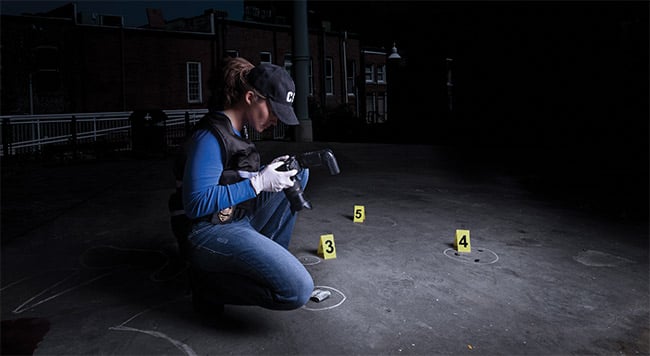
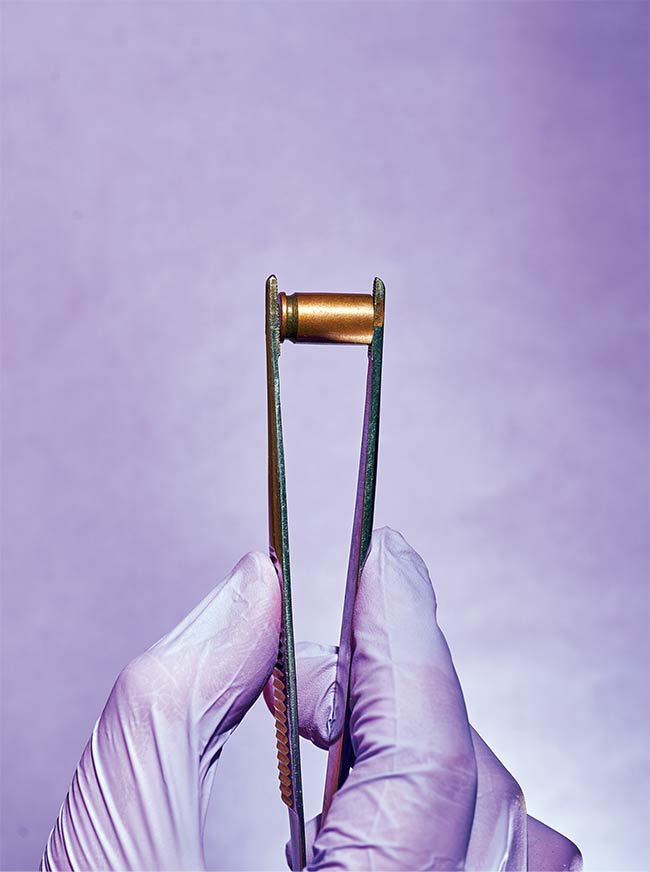
Spectroscopy has always been a promising tool for criminal investigators, offering noncontact and often nondestructive methods for deriving important
clues that may otherwise go unseen, unidentified, and unapplied in criminal investigations (top). Laser-induced breakdown spectroscopy can be used to
analyze bullet casings and gunshot residue, to provide important crime investigation data (bottom). Courtesy of Applied Spectra.
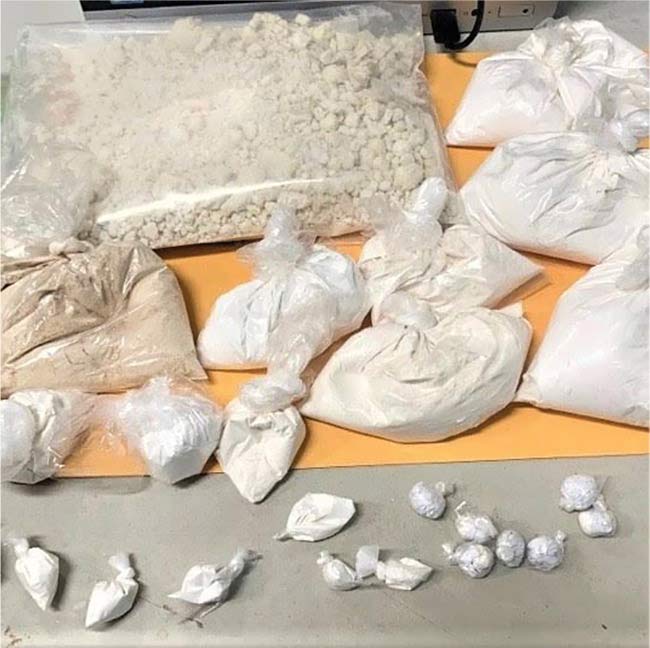
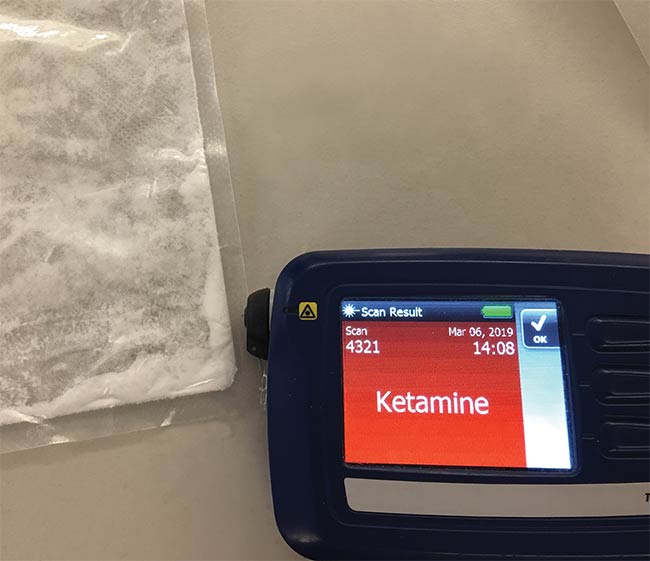
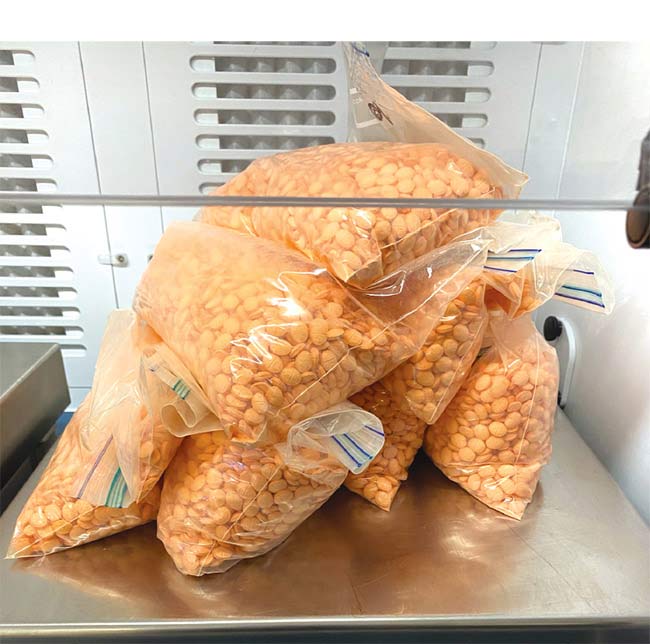
Fentanyl powder, which can appear anywhere from off-white to light brown in color, can be harmful if touched (top). Raman spectrometers, in addition to being a noncontact analytical tool, can identify narcotics while the drugs are still safely packaged, which helps police officers and crime lab technicians to avoid unnecessary exposure.
Hand-held Raman spectrometers (middle) can identify narcotic substances in the field, saving valuable time during an investigation.
Counterfeit Adderall pills that contain methamphetamine, a narcotic (bottom). Raman spectroscopy is able to nondestructively examine a sample, and the technique also helps with evaluating the results of subsequent analytical methods. Courtesy of Patrick Glynn/Quincy Police Department.
Spectroscopy and other photonics technologies have long been of interest in criminal forensics — the use of analytical tools and tests to reveal unseen clues during a criminal investigation. Unlike some methods of chemical testing, photonics draws conclusive data from extremely small or diluted samples, and it often does so nondestructively, unlike chemical testing. Today, academic researchers and product developers alike continue to push the performance envelope of light-based methods, enabling investigators and crime labs to gain insights more quickly and safely, and with greater sensitivity, in both the lab and the field. End users are benefiting from more versatile instruments that combine various techniques, providing users with an analysis toolkit that can quickly analyze a wide variety of samples at once.
Raman spectroscopy and laser-induced breakdown spectroscopy (LIBS) illustrate these trends. Both techniques resolve a photon stream from a sample into constituent spectral elements to identify basic components of the sample or its overall composition. Both techniques also rely on the narrow-bandwidth light that lasers emit to probe the sample for identifiable substances.
Raman spectroscopy methods focus the intense monochromatic light of a laser onto a sample to generate Raman scattering. The spectral data recovered from this scattered light provides insights into a substance’s structure and total chemical composition, while leaving the sample unchanged. LIBS applies short, intense laser pulses to vaporize sample material. As the excited atoms in the microplasma plume relax back into their ground states, they emit wavelengths that are characteristic of the substance’s chemical composition. A LIBS system then captures the resulting spectra to enable elemental compositional analysis. While LIBS destroys the material it analyzes, it can often gather the data that it needs from a microscopic amount of a sample.
Portable vs. desktop
Forensic photonics has found an advocate in Patrick Glynn, lieutenant detective and commander of the Narcotics and Special Investigations Unit with the Quincy, Mass., Police Department. His unit uses ThermoFisher Scientific’s TruNarc, a Raman-based hand-held device that captures a substance’s spectral signature and compares it against a constantly updated library of known narcotics. One big benefit of the technology, Glynn said, is that investigators can often avoid opening transparent packages and handling possibly hazardous substances.
Another benefit is speed. “We’re able to identify multiple substances very, very quickly,” Glynn said. He recalled one occasion when police at a crime scene had to identify 15 different white powders, any of which may have been laced with a concentration of heroin, fentanyl, or another illicit drug. Previously, identifying the composition of such powders would have required performing a series of destructive and time-consuming chemical tests, putting his team at risk of repeated exposure to the powders.
Using Raman spectroscopy techniques reduced the risk and significantly accelerated the analysis of the samples, Glynn said. “We went through all 15 substances in about 45 minutes.”
Analysis of possible narcotics is a growing application of forensic Raman spectroscopy. In addition to the technique’s other advantages, adoption of its use is growing because of the increasing availability of hand-held devices that allow sophisticated analyses to be performed in the field.
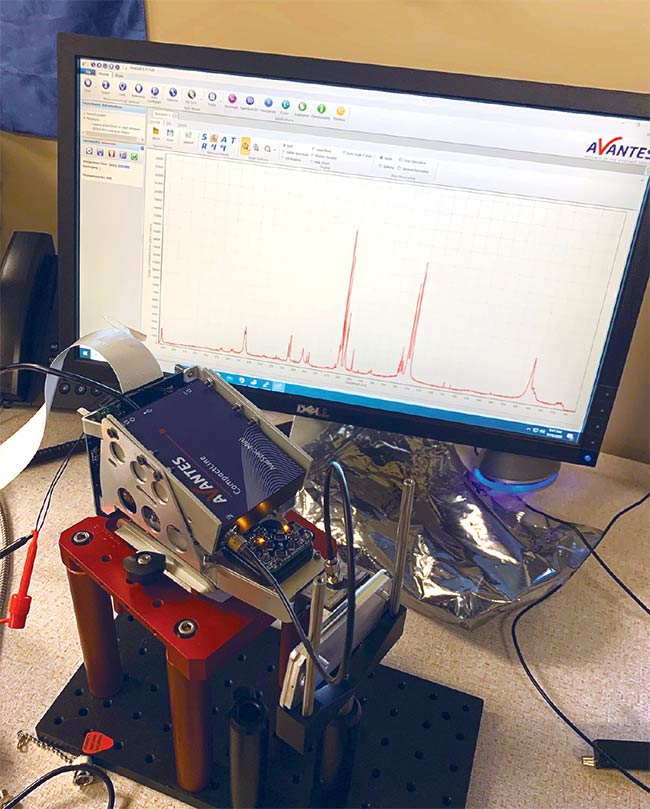
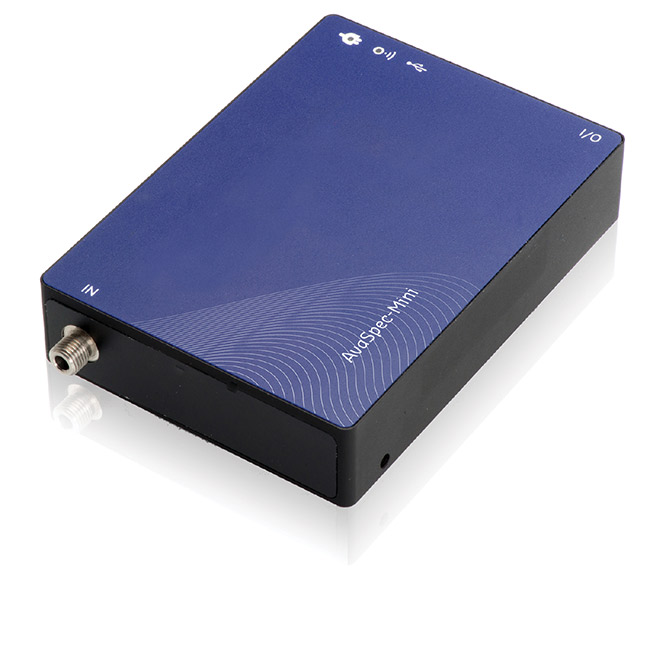
A developmental laser-induced breakdown spectrometer (top) and a compact spectrometer (bottom). Compact instruments such as both of these can bring important analytical techniques to the field during investigations.
Rigaku Analytical Devices, for instance, has developed a line of hand-held Raman systems designed for onsite analysis of chemical threats or narcotics. The instruments employ a 1064-nm laser to excite sample materials. This wavelength offers advantages over the 785-nm wavelength that is more commonly employed for Raman spectroscopy, according to Suzanne Schreyer, senior scientist for Raman products at Rigaku.
“At 1064, you don’t have the issue of fluorescence,” she said, which improves performance when analyzing through packaging or analyzing colored materials. Only so much analysis can occur in the field, however. Though desktop spectrometers are not very portable, they offer greater sensitivity and versatility.
The spectral resolution of an instrument, for example, is typically a function of its focal length, which directly correlates to the size of a spectrometer’s footprint, said Damon Lenski, general manager of spectrometer-maker Avantes USA. This correlation explains, in part, why desktop systems generally outperform portable ones. There are physics-related limits as to how small a device can be and still meet the demanding performance requirements of forensics applications.
“If instruments become too small, techniques such as Raman and LIBS, which require relatively high spectral resolution, may be undermined,” Lenski said.
‘Glass can become critical evidence in cases
related to hit-and-runs, home invasions,
and assaults.’ — Tatiana Trejos
Sergey Mamedov, an applications scientist with HORIBA Scientific, further noted that desktop instruments often leverage multiple laser wavelengths and different cameras in a single housing. Such configurations allow the option to choose the best laser and camera pairings to minimize interfering signals. Such versatility becomes particularly important when working with small samples.
“Selecting lasers at the time of measurement allows you to specify the conditions and get the maximum from the material, and so the spectrum will be clear,” Mamedov said. Compared to hand-held instruments, he added, desktop systems typically offer greater spectral resolution of the Raman signal.
Trace evidence
Raman spectroscopy techniques work best with bulk materials. Narcotics, though, are often cut with other substances, such as powdered milk, that may drop the concentration of a drug below the detection threshold. To address this potential limitation in its hand-held Raman instruments, Rigaku incorporates an automated colorimetric feature that detects residues of an unknown or nonvisible material to allow both bulk identification and near-trace detection analysis on the same field-portable analyzer.
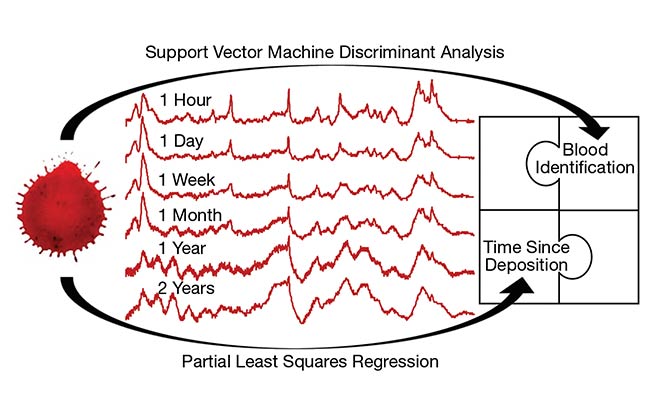
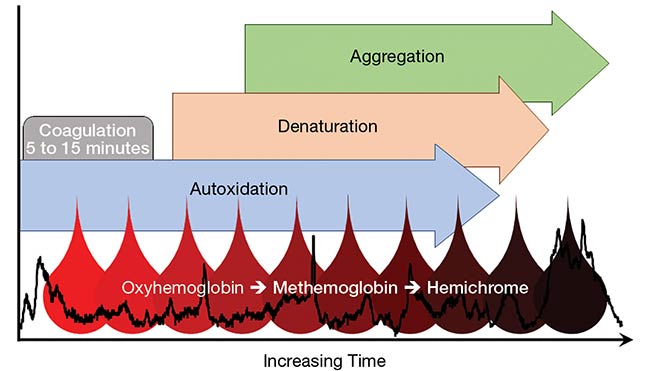
Because Raman spectroscopy gathers information about a substance’s composition and structure, it can help determine the age of a bloodstain, potentially providing an important time stamp for evidence found during a criminal investigation. Courtesy of Igor Lednev/University at Albany, SUNY.
Surface-enhanced Raman spectroscopy (SERS) offers a different way to apply Raman spectroscopy to the analysis of trace residues or dilute substances. The technique adsorbs a sample material onto a roughened metal surface, usually silver or gold, which amplifies the sample’s Raman signal by a millionfold or more and allows detection of trace residues. One potential downside to the technique is that its results do not align with conventional Raman spectra, which means SERS users must develop and maintain a separate library to identify substances, Schreyer said.
Raman spectroscopy has a number of other forensics applications beyond the identification of narcotics. Igor Lednev, a chemistry professor at the University at Albany, State University of New York (SUNY), demonstrated that Raman spectroscopy can also identify body fluids, allowing investigators to classify an unknown bloodstain as being from either a person or an animal. Body fluids have complex compositions that make analyzing them more challenging, Lednev said. Advanced computing can help to overcome these challenges, however.
“The spectrum is very complex,” Lednev said. “This is where machine learning comes into play.”
The use of Raman spectroscopy to identify traces of body fluids is forensically useful in several ways. For one, its nondestructive analysis can help to validate the results of subsequently more-destructive techniques. Raman spectra can also indicate to what extent body fluids have degraded, offering a sort of time-stamp marking that indicates how long a bloodstain, for example, has been present at a crime scene. Such information indicates whether evidence is relevant to
a particular investigation.
Research underway at various labs, including Lednev’s, could further expand the use of Raman techniques in forensics. Potential benefits include the possibility
of identifying age group, race, and sex from body fluid traces, according to Lednev.
Elemental analysis
Compared to Raman, LIBS is better suited to analyzing inorganic materials, said Tatiana Trejos, an assistant professor of forensic and investigative science at West Virginia University. Trejos and her research group studied the use of LIBS to analyze glass fragments. Pieces of glass found on a person provide compositional clues that may tie the fragments back to bottles, windows, or device screens, thereby placing the person with high likelihood at the scene of a crime.
“Glass can become critical evidence in cases related to hit-and-runs, home invasions, and assaults,” Trejos said.
LIBS also enables the detection of gunshot residue, indicating whether someone fired a gun. Another forensic application is the analysis of ink, which is important in verifying documents.
Jong Yoo, CEO of Applied Spectra, said LIBS instruments can be made portable, as evidenced by the technology’s deployment on the Mars rovers and in hand-held devices. While laser ablation
techniques destroy the sample they are analyzing, they often remove only microns of a substance at a time. Hence, even small fragments of glass or other trace evidence can be repeatedly analyzed using LIBS, while still preserving enough material for subsequent testing.
LIBS instruments offer the analytical
speed and sensitivity necessary for forensics applications, according to Yoo. But the criminal investigation field has also traditionally been among the slowest to adopt new technology because of what is at stake, he said. “You’re going to put somebody in jail or hold them accountable.”
What would help to speed adoption, he added, is round-robin testing along with more collaboration between instrument makers and users to optimize devices and techniques. The result would facilitate the development of standardized methods that would help to expand the use of LIBS in forensics.
Future forensics
Both Raman spectroscopy and LIBS have strengths and weaknesses, said Brooke Kammrath, a forensic science professor
at the University of New Haven who researches the use of these and other techniques in crime investigation applications. Both techniques offer rapid and reliable results while also creating a reviewable record — all must-haves in forensics. But Raman requires certain concentration
levels, typically at least 5% to 10%, to detect and analyze narcotics such as
fentanyl. LIBS has the sensitivity to produce elemental analyses, but the signals that it derives can be dependent on the matrix that the elements are found in. LIBS is also a comparatively destructive technique.
But, like forensics, spectroscopy is not limited to a single analytical path. Raman, LIBS, and other methods can be complementary techniques, and often are, and instrument-makers are increasingly seeking to combine them in a single tool.
Applied Spectra, for instance, has developed an instrument that combines LIBS with laser ablation mass spectrometry, Yoo said. Other vendors are working to combine LIBS either with Raman techniques or with x-ray fluorescence in a single platform. Having multiple, complementary methods can help to extract as much information from a sample as possible to produce better evidentiary results.
The cost and expertise required to apply any method or combination of methods must be weighed against the possible benefits, however, and the benefits can be measured by the conclusiveness of the results in court. Kammrath said, “There’s this balance between getting the best instrument and information, and getting good enough information to solve the problem.”